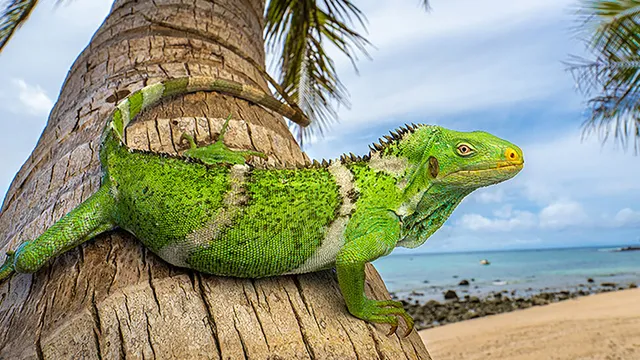
Iguanas made epic 5,000-mile journey to Fiji on rafts of vegetation
2025-03-20 08:40- Researchers studied the genetics of 14 iguana species, linking Fijian iguanas to North American desert iguanas.
- The study suggested that iguanas traveled 5,000 miles to Fiji via mats of uprooted vegetation.
- The findings highlight the resilience of iguanas and have implications for conservation efforts.
Express your sentiment!
Insights
In a groundbreaking study published in the Proceedings of the National Academy of Sciences, researchers explored how iguanas, native to the Americas, arrived on the remote Pacific islands of Fiji. Upon analyzing the genetics of 14 iguana species, they discovered that the last common ancestor of Fijian iguanas and desert iguanas from North America split approximately 31 million years ago. This timeframe coincides with volcanic activity that formed the Fijian archipelago, indicating a plausible pathway for these reptiles. The team proposed that the iguanas made an extraordinary journey of nearly 5,000 miles on mats of uprooted trees and vegetation, which they termed ‘rafting.’ Additionally, previous observations had shown iguanas making shorter rafting trips, thereby supporting the feasibility of such a long voyage. The study emphasized that iguanas' unique characteristics, including their resistance to dehydration and herbivorous diet, would have equipped them well for the grueling journey. The implications of this research illuminate the incredible survival strategies of these reptiles, as well as the impact of evolutionary genetics in tracing species origins. Understanding how Fijian iguanas arrived on their isolated archipelago is crucial for conservation efforts, particularly in light of the presence of invasive species threatening their survival, and the ongoing efforts required to protect endangered iguana populations.
Contexts
The history of iguana species in Fiji is a significant topic of study, encapsulating the evolution, adaptation, and conservation efforts of these unique reptiles in the Pacific region. Iguanas, which belong to the family Iguanidae, have a diverse range of species, but those found in Fiji are particularly noteworthy for their specific adaptations to the island environment. The Fijian iguanas, primarily the Fiji banded iguana (Brachylophus vitiensis) and the Fiji mabuya (Brachylophus vitiensis), have evolved distinct characteristics that are suited to the lush, tropical climate of the islands. Their diet predominately consists of flowers, leaves, and fruits, which reflect the rich botanical diversity of the Fijian landscape. However, the isolation of these islands has led to the development of unique behaviors and physical traits within Fijian iguanas, making them a fascinating subject for biological research and conservation efforts. The introduction of non-native species and habitat destruction has considerably impacted the populations of iguanas in Fiji, making them vulnerable to extinction. Predators such as rats and feral cats have decimated their numbers, while human activities like deforestation and urban development have further compromised their habitats. Efforts to conserve iguana populations have been initiated by various organizations in collaboration with the Fijian government. Captive breeding programs, habitat restoration, and public awareness campaigns aim to protect these iguanas and their ecosystems. Conservationists are also focusing on enforcing protective measures to reduce poaching and illegal wildlife trade, which pose additional threats to these reptiles. Research into the genetics and ecology of Fijian iguanas is crucial for understanding their adaptive strategies and ensuring their survival. Studies have shown that these iguanas have developed remarkable adaptations to their environment, such as distinctive coloration and build variations that help them camouflage in their surroundings and evade predators. Furthermore, ecological assessments of the iguana's habitats have revealed the importance of native plant species in their diets and reproductive success. This knowledge not only aids in immediate conservation efforts but also contributes to long-term strategies to maintain biodiversity in Fiji. In conclusion, the history of iguana species in Fiji highlights the interplay between ecological dynamics, conservation challenges, and human impacts. The continued survival of Fijian iguanas is contingent upon integrated conservation strategies that incorporate scientific research, habitat protection, and community involvement. As these species face mounting threats from a rapidly changing environment, the collaboration between local communities, government agencies, and international organizations becomes vital in securing a future for iguanas in Fiji. The preservation of these unique reptiles is not only crucial for maintaining ecological balance but also for safeguarding the cultural heritage of the islands.